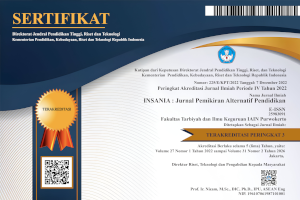Pengembangan Bakat dan Minat
DOI:
https://doi.org/10.24090/insania.v20i2.1437Abstract
Abstract This study show that in the development of the talent of a child, to note a few things, among them: (1) caution; (2) motivation; (3) support; (4) knowledge; (5) exercise; (6) award; facility; (8) environment; (9) cooperation; and (10) good examples. The interests of a child include feelings of pleasure or interst in the objects that make someone pay attention to favored objects well as their knowledge about an object. To recognize student who are gifted and have interest, the subject's teacher or class teacher is the most reliable, because every time they intercommunicate with students. There are several kinds of talent development program and interests of students that can be applied in school. First, the enrichment. Providing opportunities and facilities that are deeping the additional learning to gifted students after completing the regular task. Second, accelaration. Students are allowed to jumping class, or complete the regular program within a shorter time. Third, a special grouping, wich gives children the opportunity spesifically to gain learning experiences that match their interest and potential. Fourth, review of research institutions and development or the provision of assistance gifted students. Keywords talent, enthusiasm, talent development program, gifted studentsDownloads
Downloads
Published
How to Cite
Issue
Section
License
Authors who publish with this journal agree to the following terms:
Authors retain copyright and grant the journal right of first publication with the work simultaneously licensed under a Creative CommonsAttribution-ShareAlike License that allows others to share the work with an acknowledgment of the work's authorship and initial publication in this journal.
Authors are able to enter into separate, additional contractual arrangements for the non-exclusive distribution of the journal's published version of the work (e.g., post it to an institutional repository or publish it in a book), with an acknowledgment of its initial publication in this journal.
Authors are permitted and encouraged to post their work online (e.g., in institutional repositories or on their website) prior to and during the submission process, as it can lead to productive exchanges, as well as earlier and greater citation of published work (See The Effect of Open Access).








